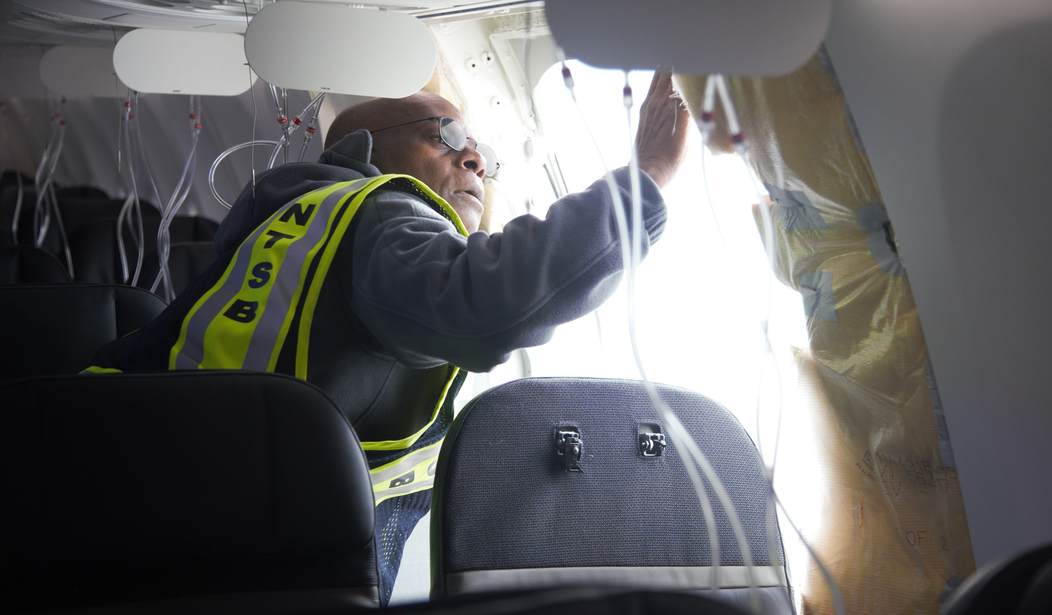NTSB Chair Jennifer Homendy updated the public Sunday evening on the agency's investigation of an incident that occurred Friday night when a door plug on an Alaska Airlines jet came off during takeoff from Portland, Oregon, during an "explosive depressurization" event.
Investigator-in-Charge John Lovell examines the fuselage plug area of Alaska Airlines Flight 1282 Boeing 737-9 MAX. pic.twitter.com/luikyh9OhG
— NTSB Newsroom (@NTSB_Newsroom) January 8, 2024
Homendy's revelations were alarming, to say the least. She said that according to records the plane involved had depressurization alerts on three prior occasions, including twice in the days before the incident.
They asked about the auto-pressurization fail light that did illuminate in three previous flights, one on December 7, one on January 3, and January 4.
In these three previous flight, after the light illuminated they flipped the switch to alt mode, which is normal. There's a backup. It was very benign. Nothing occurred. The light illuminated. They flipped it. They reported it. It was tested by maintenance, and then re-set.
I'm sure I will be asked if there is any correlation between the light that illuminated and the expulsion of the door plug. We don't know that there was any correlation of the two. It could be entirely separate.
We do know that there was a decision by Alaska Airlines, a restriction they put in place, they call it an ETOPS restriction, that prevented that plane from being flown to Hawaii, over water, so if some light did illuminate it could return very quickly to an airport.
Again, it's very much described [by Alaska Airlines] as benign, but they did order -- but they did order additional maintenance look at that light. That was not completed before the time of this event. We plan to look at that more.
She then shared the frightening scenario that occurred on the flight deck.
At the time there is a bang, the door flies open. There is a quick reference checklist that's laminated in front of them...it flies out the door.
When this explosive decompression occurred and the [cockpit] door flew open, the flight attendant reports that she saw the first officer jolt forward. The first officer lost her headset at that moment. It was pulled off. The captain had a portion of the headset pulled off, but they put their masks on, turned on the speaker so they could communicate with folks back in the cabin. Communication was a serious issue. The flight attendants reported that it was difficult to get information from the flight deck, and the flight deck was having trouble also communicating.
It's going to be more difficult to piece together everything that happened during the incident, since the cockpit voice recorders are blank.
The cockpit voice recorder was completely overwritten. There is nothing on the cockpit voice recorder...the circuit breaker for the CVR was not pulled. The maintenance team went out to get it, but it was right at about the two hour mark, and it was completely overwritten. At two hours it re-records over it, so we have nothing from the CVR.
Homendy explained that there are at least three investigations in recent years where CVR contents were overwritten due to the time frame, and that a proposed FAA rulemaking would mandate that CVR's in new airplanes have CVR's with a 25-hour recording time, which brings U.S. regulations in line with those in Europe. That rulemaking wouldn't affect planes in the air currently, and Homendy publicly called for FAA to mandate the 25-hr CVR's in current planes as well.
On Monday the NTSB recovered the door plug, which was found by a teacher named Bob in his Portland backyard.
NTSB has recovered the door plug from Alaska Airlines Flight 1282 Boeing 737-9 MAX. NTSB investigators are currently examining the door plug and will send it to the NTSB Materials Laboratory in Washington, DC for further examination. pic.twitter.com/fqeemNeBPW
— NTSB Newsroom (@NTSB_Newsroom) January 8, 2024
It's disturbing that the depressurization alerts weren't investigated more thoroughly; if there's a reason it should not fly over water, the plane shouldn't fly over land, either.














Join the conversation as a VIP Member